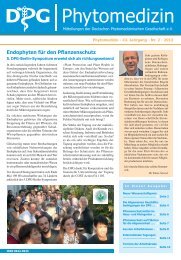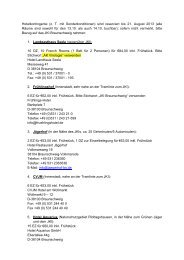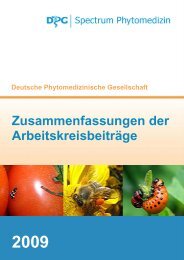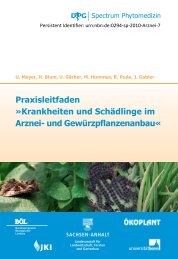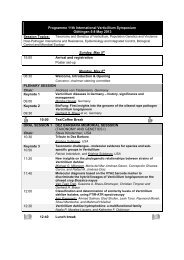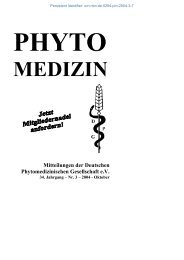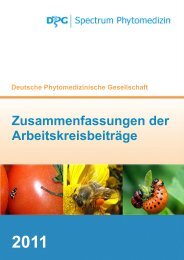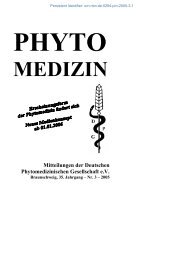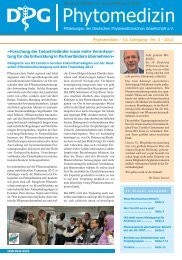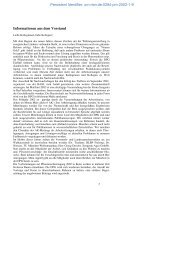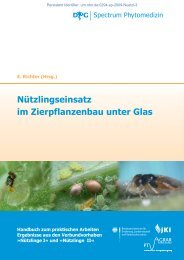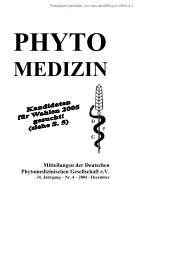fourth joint meeting of dutch and german
fourth joint meeting of dutch and german
fourth joint meeting of dutch and german
Create successful ePaper yourself
Turn your PDF publications into a flip-book with our unique Google optimized e-Paper software.
Sequence analysis <strong>of</strong> a serogroup IV tospovirus isolated from Lycospericum esculentum in<br />
Thail<strong>and</strong><br />
D Knierim, R Blawid <strong>and</strong> E Maiss<br />
University <strong>of</strong> Hannover, Institute <strong>of</strong> Plant Diseases <strong>and</strong> Plant Protection, Hannover<br />
E-mail: knierim@ipp.uni-hannover.de<br />
Tomato plants (Lycopersicum esculentum) cultivated at the Asian Institute <strong>of</strong> Technology (AIT) in<br />
Thail<strong>and</strong> showed symptoms typical for a tosopvirus infection. Serological tests revealed no reaction<br />
with an antiserum specific for tospoviruses <strong>of</strong> serogroup I, II <strong>and</strong> III (TospoBroadRange; LOEWE ®<br />
No.07507). However, antibodies specific for tospoviruses <strong>of</strong> serogroup IV (AGDIA ® SRA 61500)<br />
strongly reacted with saps <strong>of</strong> infected plants. The main objective was to determine the nucleotide<br />
sequences <strong>of</strong> the serogroup IV tospovirus. The tospovirus was mechanically transmitted to<br />
Nicotiana benthamiana <strong>and</strong> Lycopersicum esculentum cv. Lizzy plants. Total RNA was extracted<br />
<strong>and</strong> RT-PCR using primer J13 (CCCGGATCCAGAGCAAT), with conserved eight terminal<br />
nucleotides found in all tospovirus RNA termini (underlined) was used together with primers<br />
designed from conserved regions <strong>of</strong> serogroup IV tospoviruses. Six PCR fragments from the RNAends<br />
were generated, cloned <strong>and</strong> sequenced. Additional amplification <strong>and</strong> cloning steps were<br />
performed with primers located in the determined regions to complete the sequences. From the M-<br />
<strong>and</strong> L-RNA PCR-fragments <strong>of</strong> about 4000 nt were amplified with the Phusion TM high-fidelity DNA<br />
polymerase (Finnzymes). The L-RNA comprises <strong>of</strong> 8912 nt <strong>and</strong> codes for the RNA-dependent<br />
RNA-polymerase. Two ORFs are located on the M-RNA (4823 nt) encoding the Nsm protein <strong>and</strong><br />
the viral glycoprotein precursors (G1/G2) separated by an intergenic region <strong>of</strong> 433 nt. ORFs coding<br />
for NSs- <strong>and</strong> N-protein were identified on the S-RNA. However, the sequence <strong>of</strong> the S-segment<br />
intergenic region has still to be confirmed. The N-protein showed with 92,7% the highest aminoacid<br />
sequence similarity to the recently described Capsicum chlorosis virus (CaCV, AY036058). A<br />
sequence similarity <strong>of</strong> 84,4% was found to Groundnut bud necrosis virus (GBNV, NC_003619) <strong>and</strong><br />
<strong>of</strong> 85,5 % to Watermelon silver mottle virus (WSMoV, NC_003843). According to these findings we<br />
consider the new tomato infecting tospovirus from Thail<strong>and</strong> as an isolate <strong>of</strong> CaCV, tentatively<br />
named as CaCV-AIT.<br />
Natural variation in Pepino mosaic virus<br />
RAA van der Vlugt 1 , C Cuperus 1 , A Dullemans 1 <strong>and</strong> CCMM Stijger 2<br />
1 2<br />
Plant Research International BV, Wageningen <strong>and</strong> Applied Plant Research, Naaldwijk<br />
E-mail: rene.v<strong>and</strong>erVlugt@wur.nl<br />
In 1999 Pepino mosaic virus (PepMV), a member <strong>of</strong> the potexvirus genus, was diagnosed in Dutch<br />
glasshouse tomatoes. Since then the virus has established itself in Europe <strong>and</strong> many other<br />
countries worldwide. Comparison with the original PepMV, first <strong>and</strong> last described in 1980 from<br />
pepino plants (Solunum muricatum) from Peru, showed reproducible biological <strong>and</strong> molecular<br />
differences. These differences lead to the conclusion that the isolates from tomato should be<br />
considered a distinct strain <strong>of</strong> PepMV.<br />
Most tomato isolates appear very similar both in biological <strong>and</strong> molecular properties. However<br />
differences in symptom development <strong>and</strong> severity on PepMV infected tomato plants in different<br />
European countries <strong>and</strong> different growing conditions have been reported. This has led to some<br />
controversy over the phytosanitary status <strong>of</strong> the virus.<br />
Since 1999 the virus has become widespread in the Netherl<strong>and</strong>s as in some other European<br />
countries. This is partly due to the easy spread through infected fruits that contain high<br />
concentrations <strong>of</strong> the mechanically transmitted virus. Generally the virus causes only mild<br />
symptoms under Dutch conditions. However, more serious symptoms on fruits <strong>and</strong> plants have<br />
been reported sporadically. To investigate the variability <strong>of</strong> the virus <strong>and</strong> possible correlations with<br />
presence or absence <strong>of</strong> symptoms a large number <strong>of</strong> isolates from different greenhouses were<br />
collected <strong>and</strong> investigated. Detailed comparisons between these isolates, the original tomato <strong>and</strong><br />
pepino isolates <strong>and</strong> other deviant PepMV isolates will be discussed.<br />
18



